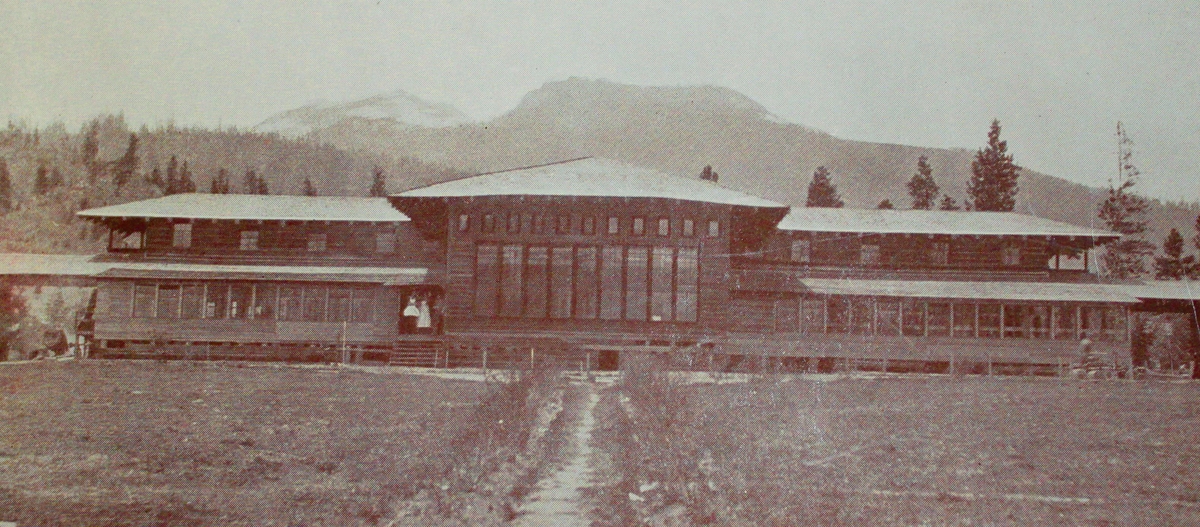“Beginning in 1933, I lived in a home designed by the famous architect, Frank Lloyd Wright,” said Sharon Zoske Wilkerson of East Missoula. “My father was a pruner at the McIntosh-Morello Orchards near the little town of Darby, Mont. We lived in a three-bedroom bungalow on the property.”
A whole generation of events occurred between the time when the Zoskes lived at the orchard and when Wright designed the orchard buildings. Actually, the story starts even before then, because the land’s location in the Bitterroot Valley was an important factor. The frost-free days normally stretched to over 125 days.
After settlement in the Bitterroot Valley, it was soon discovered that apple trees grew well on the bench lands if they were watered. The area’s claim to fame was the McIntosh Red apple, harvested right after the first fall frost, setting the tartness and making the apple flavorful.
The apple’s success led to planting of not only apple orchards but also tart cherry orchards to compete with those in Washington State.
Como Orchard Company
Como Orchard Company, a subsidiary of a Bitterroot Valley Irrigation District, owned 3000 acres at the southern, narrow, and well-protected part of the Valley. In 1907 the company planted 1600 acres of fruit trees on logged land.
To the orchard growers, the dry climate was a disadvantage.
Water cascaded off the mountain slopes in the spring, but it needed to be harnessed. For the orchard to be successful, funding was found to dam up Tin Cup Creek to become both Tin Cup Lake and Kerlee Lake, providing irrigated water via a ditch that ran through the orchard.
To make money to finance their projects, owners hatched a plan to section off the orchard into approximately 5-acre tracts and to entice professors, authors, and other intellects from the Midwest, especially around Chicago, to buy into a unique resort. It was named University Heights.
Retreat for Professionals
The pitch was to convince these professionals, who had summers free, to buy at least two lots, or 10 acres, and a bungalow on a site at University Heights for $400 an acre with the idea that the trees on this land would start producing in five years. The management would care for the buyer’s orchard, and when the trees produced, the management would begin receiving one-tenth of the net profits.
This provided a summer retreat for the professionals, where they could fish, hike, and relax away from the Midwest’s steamy heat while also having an investment.
Frank Lloyd Wright
Wright became involved in the plan around the end of 1908. Becoming the contracted architect, he designed each building and created a site plan for the Heights, showing 53 bungalows surrounding a clubhouse. Eighteen investors had signed up by November 1908. Right away, 12 bungalows—only one with a kitchen—and the clubhouse, where everyone would congregate at mealtime, were completed by March 1910.
The rambling clubhouse was 213 feet in length, built with Wright’s flair, with many low-pitched roof lines and shallow, wide steps. The building exuded the feeling that it had evolved from the terrain. It consisted of two dining rooms, a large two-story lobby in the center, three fireplaces, long porches, large commercial kitchen, and bedrooms on the second floor for visitors and employees. The manager’s office building was constructed nearby.
“A generation later, when we lived in the largest bungalow, almost nothing remained in a condition that would have been a shining example of Wright’s work,” said Wilkerson. “I don’t think anyone in the family placed much importance on the designer of the bungalows and the nearby clubhouse. When Wright designed the buildings, he would have been a young architect, known only in the Chicago area.”
Failed Project
Even with some of the plan enacted, by 1912 the project was a financial disaster. The owners underestimated costs and had many debts. Lawsuits against the company were numerous. The Company filed for bankruptcy in 1916. By 1923, the project was sold to McIntosh-Morello Orchards, Inc., who attempted to build up the orchards.
During abundant crop years, as many as 300 persons worked at McIntosh-Morello Orchards. The clubhouse was used for storage and as a fruit packing house, and the second floor provided rooms where workers could stay.
Abundant crop years were mixed with years when late frosts on the upper bench lands damaged the buds and flowers and squelched the chance for a decent harvest. Because an annual apple crop was not dependable, the McIntosh-Morello Company tried another angle—to find investors and cut its losses.
The company created and distributed an extravagant marketing booklet, titled Your Opportunity in Montana, “Go West Young Man,” which named the advantages of living in the area and owning an orchard. The huge orchard would be subdivided into smaller units that the average investor could buy. This marketing project also failed.
Blight disease attacked the fruit trees and slowly killed them, and the late spring frosts forced the workforce maintaining the orchards to be cut. The orchard continued to lose money.
All But Disappeared
The land was sold not as an orchard but for raising cattle and hay. Today, apple trees can be found back along a creek in the woods among the taller evergreens that have reclaimed the land. The neat rows of healthy fruit trees are gone.
“In 1937, we left University Heights when McIntosh-Morello Orchards was sold,” said Wilkerson. Over the years the clubhouse continued to deteriorate until it was finally demolished around 1945. Eventually all but two buildings, the home where the Zoskes had lived and the manager’s office building, were demolished or burned.
University Heights Community Orchard was a project where Wright deserved much credit, but he rarely referenced it. Besides the project being a failure, the likely reason the project didn’t claim much space in books about Wright is because he went to the area only once, drew up the plans, sent them West, and carried on with his career without looking back.
The story’s ending doesn’t have to be completely gloomy. Years of toil and failure for adults can turn out to be an expansive experience for children. Sharon Zoske Wilkerson remembers having the freedom of the entire area as a 4-year old. She often stopped to visit the kind bookkeeper in the office building. She played among the trees, throughout the spacious yard, and on the wide, cantilevered stairs to the house. She even had a pet fawn until he grew beyond wanting to be fed from a bottle. All of this made for an enriched childhood at University Heights. — MSN











